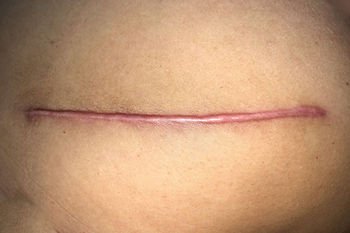Why does my caesarean scar look different? And is it normal?
Author: Amy Poole. Updated: May 22, 2024
This blog will address some of the symptoms that women commonly present with to encourage you to get the right help. It’s never too late to start working on your scar and to see improvements. Changes can still be made if your scar is over 2 years old, but this tends to take a little longer.
After giving birth via caesarean section, the initial postnatal period can feel a little overwhelming. You’ve had major abdominal surgery, you’re trying to manage your pain and medication, your mobility is significantly hindered, and this is all whilst caring for a newborn baby on very little sleep. It’s no wonder that not much thought goes into your scar beyond your initial healing.
Many mums find it difficult to engage with their scar initially. This ranges from being able to look at it, touch it, or even think about it for some. It’s therefore no surprise that when they do, often their scar has changed since the last time a midwife or other medical professional looked at it, and this can come as a bit of a shock. Many are also curious about other symptoms that they are still experiencing beyond anticipated time-frames such as tenderness, movement restrictions and numbness.
How soon can I touch my tummy and scar?
You can start to lightly touch your tummy as soon as possible, but don't massage the scar before the wound is completely healed. There should be no scab and the wound should be totally closed before starting this.
Visual Changes
Hypertrophic Scars
This type of scar is quite common after a caesarean. They are typically red and raised, and can present along the whole length of the scar or just in small patches. They occur as a result of the body producing excess collagen in an attempt to form a barrier due to moisture loss through the skin which is slightly thinner along a scar.
Keloid
Keloid scarring is similar to hypertrophic in that they are red and raised, and often darker in colour. However, the lay down of excess collagen is more extreme, and will extend beyond the border of the initial scar line. They are formed on and affected by lines of tension in the body, and are usually more uncomfortable. We also know there is a genetic component to keloid scarring, as well as being more prominent in those with Hispanic, Afro-American or Asian heritage.
Adhered scar line
Common phrases you might hear associated with adhesions are: puckered; stuck down; overhang; shelf; pouch. Where there are longer term restrictions in tissue mobility, adhesions can form which can draw in towards the midline of your body and become ‘stuck’ down. This essentially forms a ledge that any tissue above your scar line can hang over (overhang). This visual change has nothing to do with an individuals’ weight, but can appear more prominent in those who carry more adipose tissue on their tummy.
Sensory and Physical Changes
Altered sensation
This commonly presents itself as numbness, tingling, itching, a dulled level of sensation with touch, or feeling disconnected from your tummy. What often surprises women is that the area of altered sensation can be quite widespread, and is typically more notable above the scar, often as far up as the belly button. This can be due to the extended period of time your tissue is pulled up and held out of the way in order to birth your baby. This disrupts the superficial nerve endings which can take some time to restore.
Tenderness
In the initial stages of healing, tenderness and soreness is to be expected while your tissue heals and the initial swelling and inflammation subsides. Whilst it’s important to be mobile soon after your birth, resting as often as you can is key. “I’ve done too much” is a common cause of a slight increase in discomfort, so take all the help where you can and honour the early weeks of recovery.
Beyond the initial stages of healing, tenderness when touching your tummy or scar is very often also a sensitivity issue. Your tissue can become hypersensitive and even light touch can feel uncomfortable.
NB: There are many potential reasons for tenderness and soreness, so if you are concerned about a new pain, or the severity of an existing pain is increasing please seek medical advice.
Pulling and Movement Restrictions
Our body is enveloped by a type of connective tissue called fascia. Typically it helps to encourage free movement between all the different structures in our body. After any type of surgery it can become restricted where it has been physically disrupted causing tension and referred pain into areas such as the hips and lower back, and cause discomfort with certain movements or when exercising.
What can I do to help my symptoms?
There are many hands on and hands off treatment options to help with every symptom described above that you might experience after a c-section. The treatment that you choose will depend on your specific symptoms and where you are in your healing process. We use hands-on techniques, movements and sometimes negative pressure cupping device called the Lymphatouch. Look out for the second instalment of this blog where I discuss these options and how to integrate them. In the meantime if you have any questions about your scar do get in touch:
Email: amy@thenatalbody.com
Instagram: @thenatalbody
Or book an appointment with me at Alma Physiotherapy (25 Lower Redland Road, Bristol, BS6 6TB) on Thursday afternoons & Saturdays: https://www.almaphysiotherapy.co.uk/amy






